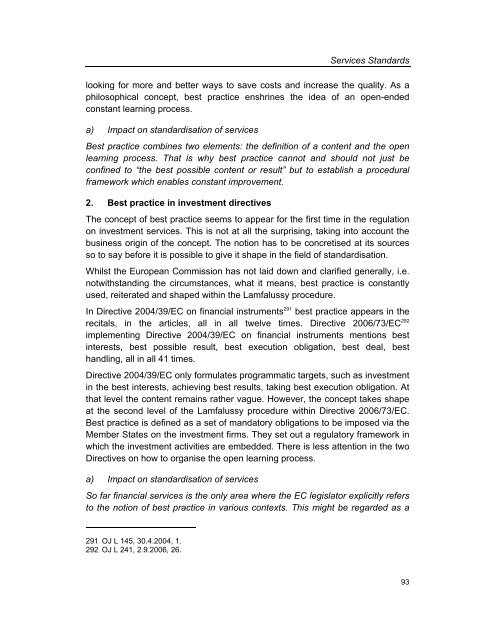Services Standards: Defining the Core Consumer Elements ... - ANEC
Services Standards: Defining the Core Consumer Elements ... - ANEC
Services Standards: Defining the Core Consumer Elements ... - ANEC
You also want an ePaper? Increase the reach of your titles
YUMPU automatically turns print PDFs into web optimized ePapers that Google loves.
<strong>Services</strong> <strong>Standards</strong><br />
looking for more and better ways to save costs and increase <strong>the</strong> quality. As a<br />
philosophical concept, best practice enshrines <strong>the</strong> idea of an open-ended<br />
constant learning process.<br />
a) Impact on standardisation of services<br />
Best practice combines two elements: <strong>the</strong> definition of a content and <strong>the</strong> open<br />
learning process. That is why best practice cannot and should not just be<br />
confined to “<strong>the</strong> best possible content or result” but to establish a procedural<br />
framework which enables constant improvement.<br />
2. Best practice in investment directives<br />
The concept of best practice seems to appear for <strong>the</strong> first time in <strong>the</strong> regulation<br />
on investment services. This is not at all <strong>the</strong> surprising, taking into account <strong>the</strong><br />
business origin of <strong>the</strong> concept. The notion has to be concretised at its sources<br />
so to say before it is possible to give it shape in <strong>the</strong> field of standardisation.<br />
Whilst <strong>the</strong> European Commission has not laid down and clarified generally, i.e.<br />
notwithstanding <strong>the</strong> circumstances, what it means, best practice is constantly<br />
used, reiterated and shaped within <strong>the</strong> Lamfalussy procedure.<br />
In Directive 2004/39/EC on financial instruments 291 best practice appears in <strong>the</strong><br />
recitals, in <strong>the</strong> articles, all in all twelve times. Directive 2006/73/EC 292<br />
implementing Directive 2004/39/EC on financial instruments mentions best<br />
interests, best possible result, best execution obligation, best deal, best<br />
handling, all in all 41 times.<br />
Directive 2004/39/EC only formulates programmatic targets, such as investment<br />
in <strong>the</strong> best interests, achieving best results, taking best execution obligation. At<br />
that level <strong>the</strong> content remains ra<strong>the</strong>r vague. However, <strong>the</strong> concept takes shape<br />
at <strong>the</strong> second level of <strong>the</strong> Lamfalussy procedure within Directive 2006/73/EC.<br />
Best practice is defined as a set of mandatory obligations to be imposed via <strong>the</strong><br />
Member States on <strong>the</strong> investment firms. They set out a regulatory framework in<br />
which <strong>the</strong> investment activities are embedded. There is less attention in <strong>the</strong> two<br />
Directives on how to organise <strong>the</strong> open learning process.<br />
a) Impact on standardisation of services<br />
So far financial services is <strong>the</strong> only area where <strong>the</strong> EC legislator explicitly refers<br />
to <strong>the</strong> notion of best practice in various contexts. This might be regarded as a<br />
291 OJ L 145, 30.4.2004, 1.<br />
292 OJ L 241, 2.9.2006, 26.<br />
93
















